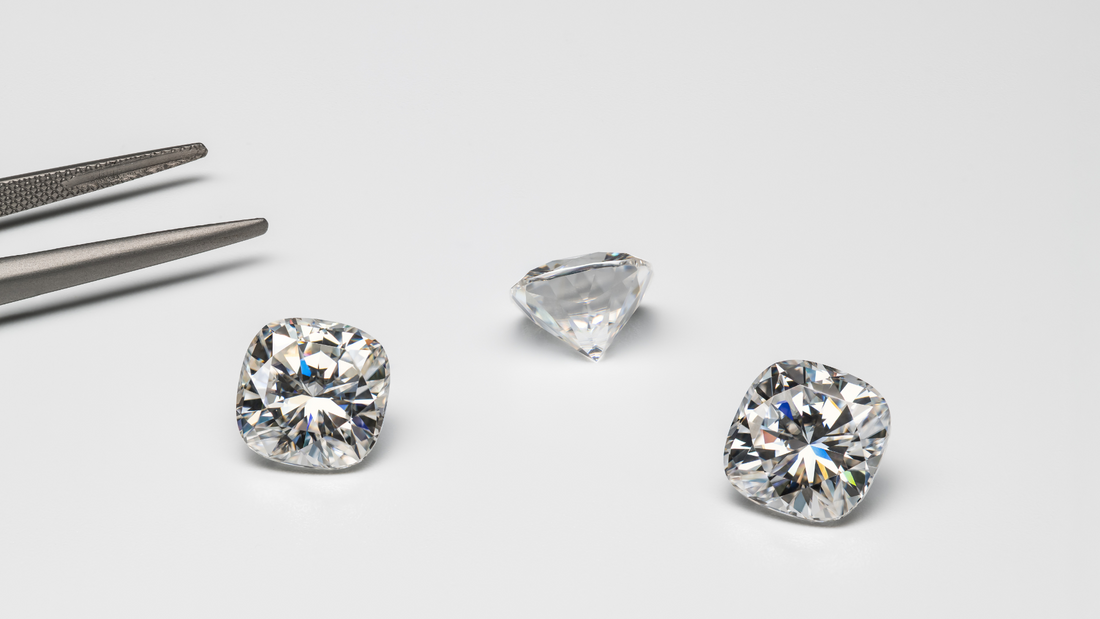Whether you're familiar with laboratory-grown diamonds or not, this article will provide you with all the information you need to make an informed diamond purchase.
What is a Natural Diamond?
While many are familiar with natural diamonds, here's a brief description: They are formed when carbon atoms undergo intense heat and pressure over billions of years, resulting in a crystal-like structure known as a diamond. These diamonds are then mined, cut into various shapes and sizes, and predominantly used in jewelry.Certifications from organizations like the Gemological Institute of America (GIA) and others confirm that the diamond you purchase is natural. It's important to ask your jeweler for certification, as it will be useful for insurance and appraisal purposes in the future. Although all diamonds aren’t certified, it’s a smart idea to at least receive an insurance appraisal stating the quality of the diamond and replacement value.
What is a Lab-Grown Diamond?
Lab-grown diamonds are a remarkable feat of modern science, sharing the same chemical composition and physical properties as natural diamonds. Unlike diamond simulants such as Cubic Zirconia (CZ) or Moissanite, lab-grown diamonds are indistinguishable from natural diamonds to the naked eye, even when using high-intensity jeweler diamond testers it can be difficult.Despite their diamond-like qualities, lab-grown diamonds are not formed naturally. They are created through two main processes: High-Pressure High-Temperature (HPHT) and Chemical Vapor Deposition (CVD). HPHT mimics the natural diamond formation process by subjecting carbon atoms to high pressure and temperature, while CVD grows diamonds from a carbon-rich vapor in a vacuum chamber using a diamond seed.
Certifications from renowned institutions like the Gemological Institute of America (GIA), International Gemological Institute (IGI), and European Gemological Laboratory (EGL) also apply to lab-grown diamonds. It's advisable to request certification when purchasing a lab-grown diamond for future insurance and appraisal needs.
Despite some claims, lab-grown diamonds are not inherently more eco-friendly than natural diamonds. Both types of diamonds have environmental impacts, and it's essential to consider all factors when making a purchase decision.
What Are the Differences Between Lab-Grown and Natural Diamonds?
The way our staff likes to explain it is this: diamonds are like ice.You can get ice from Antarctica, or you can get ice from your refrigerator, but at the end of the day, they are both molecularly ice. It is just where you get it from.
Similarly, you can get a diamond from the Earth (natural diamond), or a diamond from a Lab (lab-grown diamond), but at the end of the day, they are both diamonds.
Price:
The primary distinction between natural and lab-grown diamonds is price. Lab-grown diamonds can be mass-produced at a lower cost, making them significantly more affordable—sometimes up to 10 times less expensive. Just because the pricing is low, does not mean that the quality, cut, and coloring are compromised. In fact, you rarely see any lab-grown diamonds with a color less than G/H, and clarity VS2 which is very high on the scale.
Creation Process:
As mentioned earlier, the process of creating natural and lab-grown diamonds differs significantly. Natural diamonds are formed naturally deep within the Earth's mantle over billions of years, while lab-grown diamonds are created in controlled laboratory environments. This distinction in creation processes is a key factor in the differences between these two types of diamonds.
Rarity:
The rarity of natural diamonds compared to lab-grown diamonds is a significant factor contributing to their price difference. Natural diamonds are incredibly rare, formed naturally over billions of years under specific geological conditions. In contrast, lab-grown diamonds, while still valuable and genuine diamonds, can be produced in a controlled environment, making them more abundant and thus more affordable.
What is the best choice for me?
The decision between a natural or lab-grown diamond ultimately depends on your personal preferences and priorities. If you are more price-conscious or looking for a larger diamond without the hefty price tag of a natural diamond, a lab-grown diamond may be the ideal choice for you.
However, if you place value on the rarity, uniqueness, and potential higher resale value of a natural diamond, then opting for a natural diamond might be more suitable. Consider your budget, aesthetic preferences, and long-term goals when making your decision.
Final Thoughts:
We hope this article has clarified the differences between lab-grown and natural diamonds, assisting you in your diamond buying journey. If you're considering purchasing a diamond from us, we'd love to help! Contact us to schedule an appointment and learn more about our custom design process. You can also view pricing for Lab. vs. Natural here.

